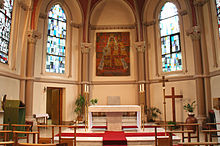Glacis Chapel (Luxembourg)
The current Glacis Chapel (Luxembourgish: Glaciskapell) stands where the first, of the same name, from 1626 stood. The current one was built at the request of Bishop Nicolas Adames , according to plans by the state architect Charles Arendt . The consecration was in 1885 by Bishop Jean Joseph Koppes .
history
The origin of the chapel is the miraculous image of Our Lady , which is venerated today in the Luxembourg cathedral , as comforter of the afflicted .
The chapel is 100 meters away from the place where the Jesuit priest Jacques Brocquart (1588-1660), together with his students of the Jesuit college, made one in front of the city gates, on today's glacis field Linden wood carved figure of Mary set up for veneration. The foundation stone for a small chapel was laid in the following year. When the plague broke out in 1626 and the priest himself fell ill, he vowed to complete the chapel if he got well again. After this happened within a short time, he kept his promise and so the sanctuary could be inaugurated on May 10, 1626. Father Brocquart called the image of grace “Comforter of the afflicted” .
Soon a great stream of pilgrims began, and numerous miracles are said to have occurred. In 1639 the statue was first transferred from the glacis chapel to the Jesuit church (since 1870 the Luxembourg cathedral ), venerated there for eight days (= one octave) and brought back to the chapel on the glacis in a solemn procession. Hence the Luxembourg national pilgrimage of the so-called Octave of the Mother of God . At the time of the French Revolution, the glacis chapel was destroyed, which is why the miraculous image has been permanently in today's cathedral since 1794.
The current glacis chapel is a new creation from 1885 in the old location, the origin of the Luxembourg national pilgrimage.
window
Six large windows by Emile Probst from 1966 form a cycle that tells the story of the worship of Our Lady in Luxembourg. They were used in 1966 for the 300th anniversary of the election of Our Lady as patroness of the city, the so-called "Tricentenaire". Pictured the years:
- 1624: The Jesuit priest Jacques Broquart leads the first statue of the "Tréischterin" ("Tréischterin am Leed" by Trösterin in Leid, also Consolatrix afflictorum ) through the city
- 1628: Copy of a window in the first chapel
- 1642: An engraving of the statue comes to Kevelaer by Luxembourg soldiers
- 1666: Maria is named patroness of the city
- 1684: Our Lady appears to the soldiers above the walls of the destroyed city
- 1866: “Bicentenaire” (200th anniversary celebration) the papal legate of Pope Pius IX. sends a crown to the statue of Our Lady
Still worth seeing
The large tapestry in the choir of the church, like the windows, was presented to the Tricentenaire in 1966. It shows Maria the comforter of the afflicted and comes from E. Probst and his wife.
In the chapel are the graves of the first two bishops of Luxembourg, Nicolas Adames and Jean Joseph Koppes .
Coordinates: 49 ° 36 '53.5 " N , 6 ° 7' 19.7" E

